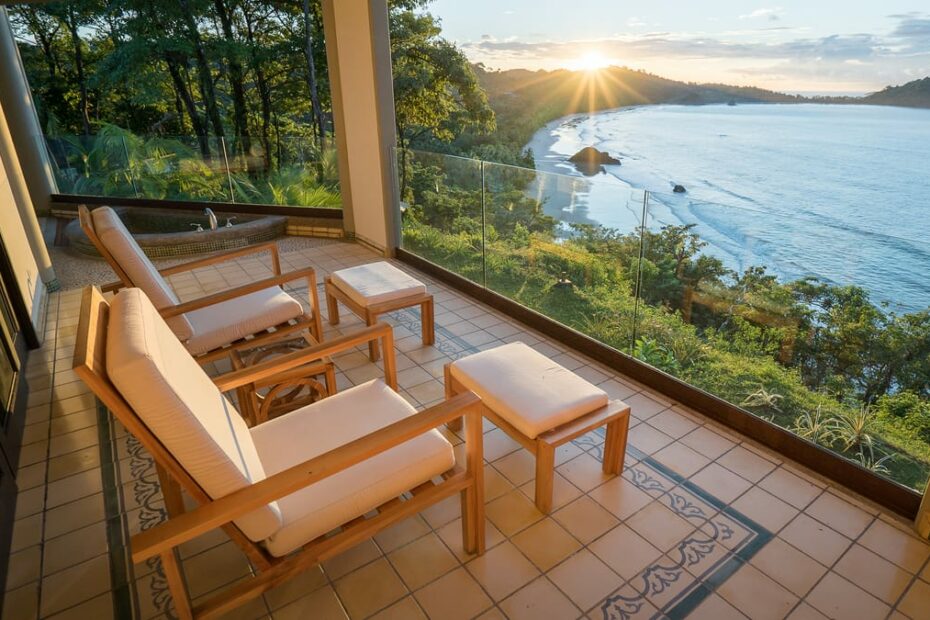Well, some say so. Today, some prominent Costa Rica tourism pros launch a brand new initiative to raise private investment into some of the country’s most successful existing projects. Welcome to the new world of the Costa Rica tourism bond.
The idea is simple. You take an ongoing tourism business in Costa Rica, one that’s already established and a proven success. Then you invite outside investors to help contribute to the businesses further success. They do that by making a returnable investment in bonds which will inject capital into the business.
In return for their contribution, the investor will receive an annual return plus an allotment of nights at the hotel they’re investing in.
The investment will have a fixed term. At the end of the term, the investor will receive back in full whatever they put in. During their term, they’ll receive special perks at the property they’ve put their money into. Kind of like owner’s privileges. Let’s dig a little further into this concept, looking at the whats and the hows.
But first let’s start with the whys.
It’s no secret the pandemic has done enormous damage to travel and tourism businesses around the world. Costa Rica is no exception. In fact, in a country as reliant on tourism as Costa Rica is, the economic effect has been all the more acute.
Like many other countries, Costa Rica closed its borders to foreign tourism in March 2020. It didn’t reopen them until August 1 last year, and then only to all U.S. travelers in November.
U.S. tourists represent the vast majority of visitors to Costa Rica, with 1.3 million of them arriving out of a total of 3.1 million in 2019. So, from March to August 2020, there was no international tourism at all. Then from September to November, there was a trickle of American tourists as Costa Rica gradually opened up to the U.S.
This slow reopening wasn’t enough to save many businesses.
Beach towns and rural communities all over Costa Rica saw their unemployment levels soar to near 100 percent levels. Hotels, restaurants, tour companies, and other businesses closed their doors, many for good.
Proud families found themselves relying on charity to feed themselves. The industry screamed in pain and no-one listened.
Costa Rican tourism is built on smaller hotels, boutique spaces.
Places without millions of dollars to back them up from corporate offices back in North America or Europe. Sure, we have these big chains down here, your Marriotts and Barcelos and the rest. But they don’t make up the essence of what Costa Rica represents for a tourist.
It’s the smaller places that make up that essence, and they were the ones hit the hardest.
For a while, it seemed like only the big boys would survive, changing the face of Costa Rica’s unique, boutique brand of tourism forever. Smaller hotels and businesses needed a break, but couldn’t get one.
The idea of the government forming some kind of fund in combination with the banks to keep businesses alive was floated about, but in the end went nowhere. It seemed like neither the government nor the banks had any real interest in keeping tourism afloat in Costa Rica.
Costa Rican tourism survived by the skin of its teeth in the end.
The united efforts of business owners and communities all over the country, plus a capable and dedicated tourism minister in the shape of Gustavo Segura, ensured we got through the worst of the border closures. Many businesses failed, but many survived through sheer grit and determination.
As it stands right now, tourism is back in Costa Rica.
Not to the extent it was pre-pandemic yet, of course. But it’s back and improving. Global vaccination programs have created a new confidence in travel again, and insiders expect 2022 to be a real bounce-back.
According to the New York Times, Americans now have more savings than they did pre-pandemic, some trillion dollars more than in early 2020.
A New York Times/Survey Monkey poll conducted in March showed that around 35 percent of Americans plan to spend more money on travel over the course of the next year than they would do normally. After a year inside, people are itching to get up and go.
The future looks good for Costa Rican (always one of Latin America’s strongest tourist brands) and global tourism over the next few years.
U.S. consumers have saved $2.4 trillion since the start of the pandemic https://t.co/nIDPZsYKXP
— Axios (@axios) June 28, 2021
But starting out again in the wreckage of the pandemic has taught Costa Rican tourism some lessons.
It’s learned to not rely on government or banks for help, and that the industry needs some special kind of unity, some special kind of fund, to help itself and preserve the uniqueness that attracts travelers in the first place.
And that’s where the idea of the Costa Rica Tourism Bonds took hold in the mind of Namu Travel co-owner Richard Bexon, the person behind the initiative (and a regular contributor to this website, as well).
“Even before the pandemic, it was a slow and difficult process for Costa Rica tourism businesses and entrepreneurs to raise the capital they needed to either set themselves or expand,” he says.
“During the height of the lockdowns last year, I saw so many great businesses here losing everything they have, all the while trying to keep their staff from the breadline and in work. Nobody was giving them a break and something needed to be done.
“We figured that if we could create some kind of fund for tourism businesses to not only see them and their staff through hard times, but also expand and improve during good times, we could perhaps ensure that what we saw in 2020 would never happen again.”
But how to do that? How would you get ordinary investors, many of whom have little or no association with Costa Rica, to invest into tourism projects in the country?
You take a look at the timeshare business, that’s how. Take some of the best aspects of that business and throw away the worst.
It’s worth pointing out right here and right now that Costa Rica Tourism Bonds are NOT timeshares. Let’s repeat that for full and clear understanding. Costa Rica Tourism Bond are not timeshares.
With a timeshare, you pay for time in the form of nights at a property over a set period of time. Once that period of time expires, you no longer have the right to use it, and are not returned your original investment. You’ve effectively paid in advance for nights in a property, nothing more. Sure, you can sell your allotted nights to others if you want, but a timeshare is not in any way an investment.
But a tourism bond gives you an annual return, plus nights at the property, and any “owner’s privileges” that might come your way.
And at the end of the bond you get your original money back, free and clear.
“It’s a unique opportunity in the post-Covid recovery,” says Bexon.
“One thing the pandemic has taught us is the importance of a healthy and fulfilling lifestyle, not only financially, but across all aspects of life. There’s no better place than Costa Rica for developing the lifestyle you need for yourself and your loved ones. If you’re invested into the tourism dream of Costa Rica through our Costa Rican Tourism Bonds, you’re not only helping a successful industry thrive, but you’re also opening yourself up to possible residency in the country.”
That last bit is important, by the way. Costa Rica recently passed its new law to attract investors, by lowering the minimum investment required to $150,000.
In a recent podcast, immigration lawyer Cristina Guerrini said that investment in tourism bonds could be a gateway to residency in Costa Rica.
But for those for whom residency might not be on the cards, the bonds still make sense.
“With an open calendar,” continues Bexon, “You’ll finally get back to having the freedom of traveling the way you like, with flexibility to go where you want when you want. Enjoy access to concierge services and amenities at your exclusive private investment property, and build memories and reinforce relationships that last a lifetime. We’re proud to introduce these lifestyle bonds and to be a part of helping to make special memories for families and friends.
“Until now, the only real investment options for tourists to Costa Rica were in real estate. But Costa Rica Tourism Bonds will open up another door of investment opportunity for people. These bonds offer a balance between a sustainable lifestyle and steady returns in some of Costa Rica’s most beautiful and unique hotels.
“Investing in tourism bonds means you’re essentially becoming a part-owner/investor of a high-profile, reputable organization that has been carefully selected by our team of experts. Each venture only has a limited number of bonds available, and there will be a minimum investment level.”
Right now, Costa Rica Tourism Bonds offers the investment opportunities outlined by Bexon with three different, unique properties around the country.
One of these properties is Arenas Del Mar, a five-star luxury boutique resort in Manuel Antonio on Costa Rica’s Central Pacific coast.
Managed by the Cayuga Collection, Arenas Del Mar has seen year-on-year pre-pandemic growth since it opened in 2007. The hotel is looking at a great post-pandemic recovery too, with strong bookings through the rest of 2021 and into 2022.
Arenas wants to expand more into the vacation rentals sector – a growing post-pandemic trend – and plans to build luxury treehouse villas. This is the type of project that the Costa Rica Tourism Bond Funds will help fund.
Hans Pfister from the Cayuga Collection is all in.
“This is something that tourists, investors, and the industry have been waiting for,” he says. “A product that blends a lifestyle with an investment, while helping sustainability grow successful tourism projects.”
Another hotel working with the Costa Rica Tourism Bonds Fund is Banana Azul in Puerto Viejo on the Caribbean coast.
Owned by Canadian entrepreneur Colin Brownlee, Banana Azul has been on the vanguard of change and innovation during the pandemic.
It was one of the first hotels in Costa Rica to chase the medium to long-term rental market, offering digital nomad/remote worker deals and even opening its own store to cater for longer stay guests.
Brownlee was at the forefront of the movement to get a remote worker visa passed into law in Costa Rica. The Tourism Bonds Fund will help him expand further and employ more Puerto Viejo locals.
Indeed, it’s worth pointing out that his hotel manager was one of those in charge of organizing the food banks in Puerto Viejo during the height of the pandemic.
“At the end of the day, it’s all about community,” says Brownlee.
The hotels and properties picked for Costa Rica Tourism Bonds will all have one thing in common.
They’ll all have strong environmental and social governance (ESG) or will be part of Costa Rica’s CST (Certification of Sustainable Tourism) Program. This means that investors will never need to worry about their money contributing to bad practices of any kind in Costa Rica.
So back to the original question.
Will the new Costa Rica Tourism Bond help save the sector? Well, if it doesn’t save it outright, it will help it in a massive way. And in helping the sector, it will also help rural and beach communities around Costa Rica prosper and grow.
These communities and the hotels in them will continue their good stewardship of one of the most beautiful tourist destinations in the world.
If you’d like more details or wish to request a prospectus, please contact Richard and his team at Costa Rica Tourism Bonds.
James Dyde is the editor of centralamerica.com. He lives in Escazu, Costa Rica.




